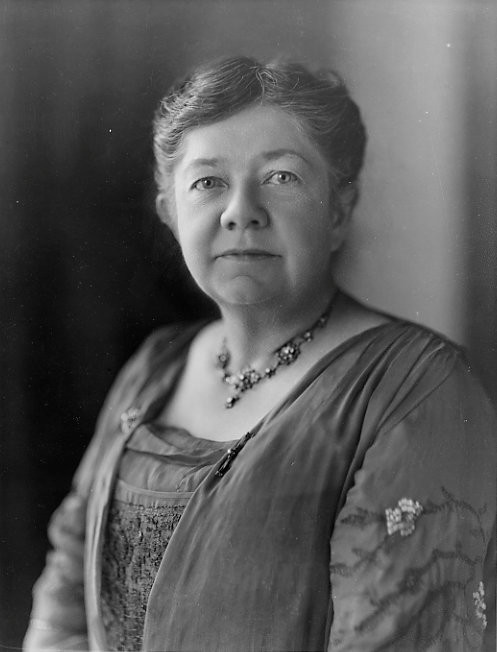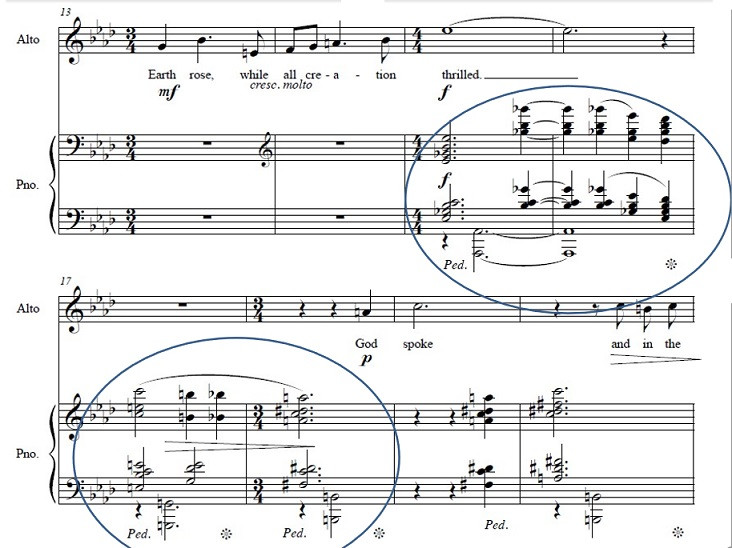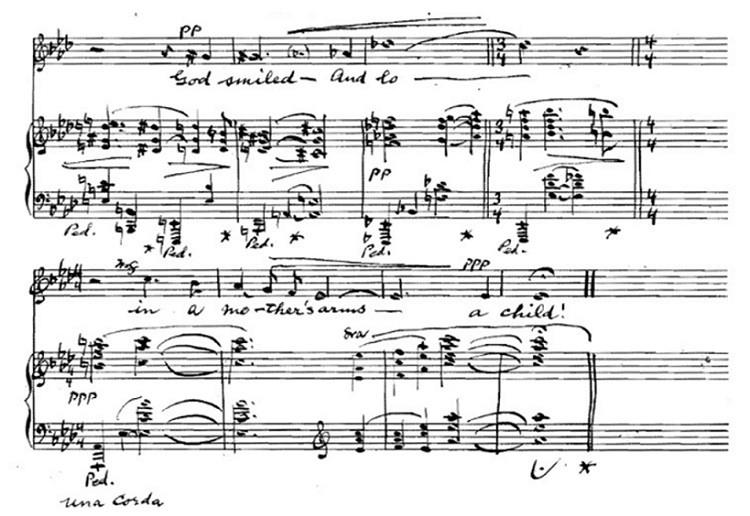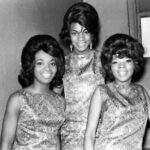Amy Beach (1867–1944) stands as a monumental figure in American music history. As the first American woman to achieve widespread recognition as a composer of large-scale orchestral works, she shattered gender barriers and paved the way for future generations of women in music. Her impressive catalog of over 170 compositions, with approximately 120 songs, showcases her profound talent and versatility. Recently, a fascinating discovery at the University of Washington Music Library has brought renewed attention to Beach’s work, revealing a previously unpublished song titled “Birth.” This unearthed manuscript offers valuable insights into Beach’s evolving compositional style and her enduring artistic spirit.
 Mrs. H. H. A. Beach, ca. 1920. Photographer, Rayhuff-Richter
Mrs. H. H. A. Beach, ca. 1920. Photographer, Rayhuff-Richter
Beach, born Amy Marcy Cheney, adopted the moniker Mrs. H. H. A. Beach, reflecting the social norms of her time. Despite societal expectations, she forged a remarkable career. Her “Mass in E-flat,” premiered when she was only 25 by the Handel and Haydn Society of Boston, garnered critical acclaim and solidified her position in the classical music world. Her “Gaelic Symphony (1896),” performed by the Boston Symphony Orchestra under Emil Paur, further cemented her reputation. Leading conductors like Leopold Stokowski and Frederick Stock championed her compositions, bringing them to wider audiences. Initially a celebrated concert pianist with a successful debut at 16, her performing career diminished after her marriage in 1885 at her husband’s request. However, this shift allowed her to dedicate herself more fully to composition. Following her husband’s death in 1910, Beach resumed performing, touring extensively in both Europe and the United States, while continuing her prolific compositional output until her later years.
 The title page of the manuscript, revealing the handwritten title "Birth" by Amy Beach.
The title page of the manuscript, revealing the handwritten title "Birth" by Amy Beach.
Unveiling “Birth”: A Song’s Context and Style
The manuscript for “Birth,” discovered during a project to catalog uncatalogued manuscripts, remained unpublished until recently brought to light. While undated and lacking an opus number, musicologist Adrienne Fried Block suggests a composition date of 1929 (Block, 308). However, alternative timelines propose an earlier creation, possibly around 1926. This dating is supported by accounts of singer Emma Roberts presenting the poem to Beach in September 1926, seeking to comfort her after surgery. Close friend Amy Bingham further encouraged Beach to set the poem to music (Jenkins, 89). Regardless of the precise date, “Birth” emerges from Beach’s later compositional period, a time marked by a stylistic evolution away from her earlier Victorian romanticism.
According to Block, Beach, while not embracing the radical modernism of composers like Varèse, Stravinsky, or Schoenberg, demonstrated a willingness to “experiment with modern idioms… she wanted to be thought of as an up-to-date composer” (Block, 224). This stylistic shift was partly influenced by her interactions with younger composers at the MacDowell Colony, where she spent summers from 1921 onwards. Exposure to modernist composers like Marion and Emilie Frances Bauer, Ethel Glenn Hier, and Mabel Daniels, along with her exposure to Debussy and others during European travels, broadened her musical palette. The influence of Debussy is subtly present in “Birth,” particularly in the harmonic language of the accompaniment, which occasionally evokes Debussy’s signature parallel chords.
 Parallel chords akin to Debussy’s in Amy Beach’s “Birth,” showcasing the modernist influences on her later works.
Parallel chords akin to Debussy’s in Amy Beach’s “Birth,” showcasing the modernist influences on her later works.
Knowles’s Poem “Birth”: A Reflection on Creation
The poem “Birth,” set to music by Beach, was penned by Frederic Lawrence Knowles (1869-1905), a New England poet. The text explores the profound and sacred miracle of birth, portraying it as a divine act of creation.
Birth
God thought: –
A million blazing worlds were wrought!
God will’d: –
Earth rose, while all Creation thrill’d!
God spoke: –
An in The Garden love awoke!
God smiled: –
Lo, in the mother’s arms, a child!
Beach’s musical interpretation masterfully captures the essence of Knowles’s poem. The song commences in a somber, almost nascent state, conveyed through the piano’s low register, symbolizing darkness and the unknown before birth. As the song progresses, the music ascends to higher registers, culminating in a bright and resonant conclusion, representing the arrival of light and new life.
 Low register chords at the prelude to the song, depicting the musical representation of darkness and beginning.
Low register chords at the prelude to the song, depicting the musical representation of darkness and beginning.
This journey from darkness to light is further emphasized by the harmonic language. Dissonant chords pervade the initial sections, creating a sense of tension and anticipation. These dissonances persist until the final phrase, coinciding with the words “a child is born,” where the music resolves into traditional harmony. Similarly, the vocal melody, characterized by augmented intervals of seconds and fourths, finds resolution at this pivotal moment. The song settles into an A-flat major tonality in the concluding section, a key Beach associated with the color blue and feelings of peace and tranquility, reflecting the “post-partum calm” after birth.
 High register chords at the end of the song, musically illustrating the arrival of light and resolution.
High register chords at the end of the song, musically illustrating the arrival of light and resolution.
Pianist Rhonda Kline suggests interpreting “Birth” as a metaphor for the Biblical creation story, drawing parallels between Knowles’s poem and the Book of Genesis. Beach’s increasing devoutness in her later years likely resonated with the religious undertones of the poem. Indeed, the musical progression from darkness to light mirrors the Genesis account of creation.
 Rhonda Kline, piano; Nataly Wickham, voice, in performance, bringing Amy Beach's "Birth" to life.
Rhonda Kline, piano; Nataly Wickham, voice, in performance, bringing Amy Beach's "Birth" to life.
The Kinscella Connection and “Birth”‘s Significance
The manuscript of “Birth” is part of the Hazel Kinscella Collection at the University of Washington Music Library. Kinscella, a faculty member at UW from 1942 to 1958, had a significant connection to Amy Beach. Their relationship began in 1918 at the MacDowell Colony, facilitated by an introductory letter from Marian MacDowell. Kinscella interviewed Beach for Musical America in 1918, marking the start of a lasting friendship. Evidence suggests ongoing contact throughout Beach’s life, including Kinscella sending Beach a Native American melody that inspired Beach’s piano piece “From Blackbird Hills” (1922). Kinscella’s correspondence and Beach’s diary entries further document their bond.
Amy Beach’s diary entry from June 21, 1937, providing a personal record of her interactions and friendships.
The precise circumstances of how Kinscella acquired the “Birth” manuscript and other Beach manuscripts remain unknown. It is plausible that Beach gifted these manuscripts to Kinscella during one of their encounters.
“Birth,” though not a major published work, holds importance in understanding Amy Beach’s stylistic journey. It reveals her early forays into modernism, showcasing influences of Debussy while maintaining her unique voice. Although she ultimately did not publish this particular Beach Song, its rediscovery provides invaluable insight into a pivotal phase in Beach’s compositional evolution, bridging her Victorian roots with her embrace of contemporary musical trends. This “beach song,” in its broader sense as a song by Beach, enriches our appreciation of her artistry and her place in American musical history.
References
Block, Adrienne Fried. Amy Beach: Passionate Victorian. NY: Oxford University Press, 1998.
Jenkins, Walter. The Remarkable Mrs. Beach. Edited by John H. Baron. Warren, MI: Harmonie Park Press, 1994.
Kinscella, Hazel. “‘Play no music when first heard,’ Says Mrs. Beach.” Musical America 28 (7 Sept 1918), 9-10. Cited in Block, 365, fn. 8.
 Judy Tsou, Emeritus Music Librarian and Guest Blogger, bringing expertise to the discovery of Amy Beach's "Birth".
Judy Tsou, Emeritus Music Librarian and Guest Blogger, bringing expertise to the discovery of Amy Beach's "Birth".
Guest Blogger: Judy Tsou
Judy Tsou is Emeritus Music Librarian at the University of Washington and a seasoned music historian. Her research focuses on gender and race in music. She played a key role in developing the Women’s Music Collection at the University of Michigan’s Music Library and co-edited Anthology of Songs (Da Capo Press, 1988). In recognition of her contributions, the American Musicological Society established the Judy Tsou Critical Race Studies Award in 2018.

